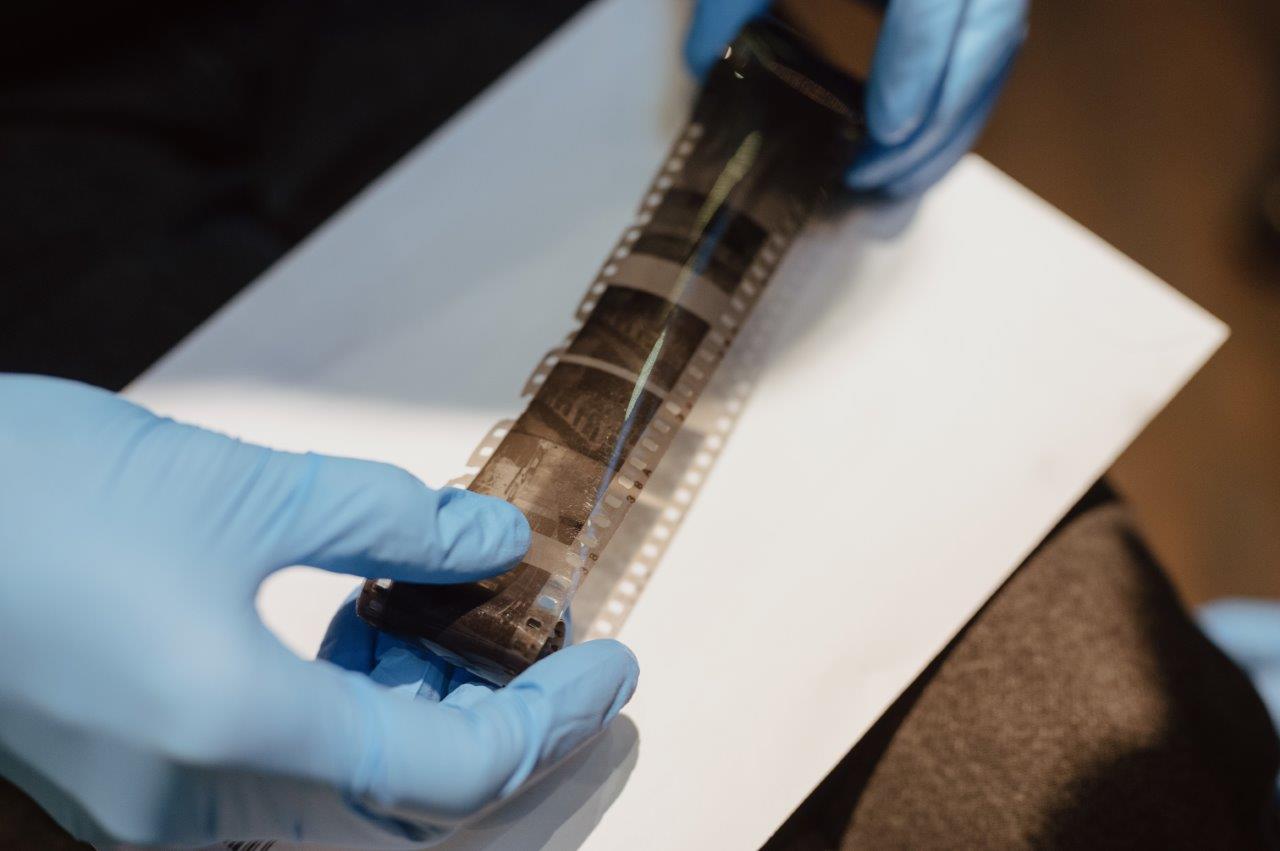
For four weeks, from April 19 to May 16, 1943, during World War II, residents of the Jewish ghetto in Nazi-occupied Warsaw, Poland, staged an armed revolt against deportations to extermination camps. The Warsaw Ghetto Uprising inspired other revolts in extermination camps and ghettos throughout German-occupied Eastern Europe. This year marks the 80th anniversary of those events, still for some within living memory.
This year there’s a new development to the story. In January, Warsaw’s Jewish history museum presented a group of photographs taken in secret during the uprising, some of which have never been seen before, that were recently discovered in a family collection.
The POLIN Museum of the History of Polish Jews described the discovery of negatives with some 20 never-seen images as highly important.
The photos were taken inside the Warsaw Ghetto by a Polish firefighter, Zbigniew Leszek Grzywaczewski, as the Nazi Germans were brutally crushing the uprising. As the Germans burned down the ghetto, they called in Polish firefighters to keep the flames from engulfing nearby buildings outside the ghetto.

The museum’s historians said that the value of Grzywaczewski’s pictures lies in their being the only known images from the ghetto uprising that were not taken by the German forces, and which therefore were not shot with the intention of serving Nazi propaganda.
Grzywaczewski, then a 23-year-old whose family members were risking their lives to save Jews, took his camera into the ghetto and secretly photographed Jews being led to Umschlagplatz, the holding area where the occupying German forces held them before deportation to the Treblinka death camp. The images also show burning buildings.
Grzywaczwski’s son, Maciej Grzywaczewski, recently found negatives with the images in the collection of his father, who died in 1993.

Shortly after the German invasion of Poland, in September 1939, more than 400,000 Jews in Warsaw, the capital, were confined to an area of the city that was little more than one square mile. In November 1940, this ghetto was sealed off by brick walls, barbed wire and armed guards. Anyone caught leaving was shot on sight. Among all the ghettos established in cities throughout Nazi-occupied Eastern Europe, the Warsaw ghetto was the largest. The Nazis controlled the amount of food that was brought into the ghetto. Disease and starvation killed thousands each month.
In July 1942, Heinrich Himmler, the head of the Nazi paramilitary corps known as the Schutzstaffel (SS), ordered that Jews be “resettled”—to secret extermination camps. The Jews were told they were being transported to work camps; however, word soon came back that deportation to the camps meant death. Two months later, some 265,000 Jews had been deported from the Warsaw ghetto to the Treblinka extermination camp, while more than 20,000 others were sent to a forced-labor camp or killed during the deportation process.
An estimated 55,000 to 60,000 Jews remained in the Warsaw Ghetto, and small groups of these survivors formed underground self-defense units such as the Jewish Combat Organization, or ZOB, which managed to smuggle in a limited supply of weapons from anti-Nazi Poles. On January 18, 1943, when the Nazis entered the ghetto to prepare a group for transfer to a camp, a ZOB unit ambushed them. Fighting lasted for several days before the Germans withdrew. Afterward, the Nazis suspended deportations from the Warsaw ghetto for the next few months.
On April 19, 1943, Himmler sent in SS forces and their collaborators with tanks and heavy artillery to liquidate the Warsaw Ghetto. Several hundred resistance fighters, armed with a small cache of weapons, managed to fight the Germans, who far outnumbered them in terms of manpower and arms, for nearly a month. The continued fighting represented a humiliating defeat for the morale of the almighty Third Reich.
During that time, the Germans systematically razed the ghetto buildings, block by block, building by building, destroying the basement bunkers where many residents had been hiding. In the process, the Germans killed or captured thousands of Jews. By May 16, the ghetto was firmly under Nazi control, and on that day, in a symbolic act, the Germans blew up Warsaw’s Great Synagogue.
An estimated 7,000 Jews perished during the uprising. Most of the estimated 50,000 others who survived were sent to extermination or labor camps, though a signifiant number escaped through tunnels and over walls and joined the partisans in the forests or enrolled in Polish or Soviet forces. It is believed that the Germans lost several hundred men in the uprising.
A new 20th-century Pharaoh
The uprising started on the first night of Passover 1943, recapitulating in the modern world the legend of the escape from Pharaoh’s slavery that the Passover holiday commemorates. Few imagined they would survive, but all agreed it was better to try to strike a blow at the oppressor than to be transported off to certain death.
Perhaps the single greatest lesson of the Warsaw Ghetto Uprising was the level of political, military and strategic unity the different factions among the Jews living there achieved. Zionists of various stripes, socialists, communists and anarchists, secular as well as religious, met secretly for months to work out their differences and agree on a common plan of resistance.
The model they established in Warsaw disproved the thinking that “Jews went to their slaughter like sheep.” To the contrary, the uprising was but one of many forms of resistance in the ghettos, camps, and in the open fields. Within months, Jewish prisoners in other ghettos and in camps such as Treblinka and Sobibor seized weapons from the enemy and revolted. They showed, as the Soviets had also at Stalingrad, that the Nazis were not invincible.
As news of the Warsaw Ghetto Uprising spread, Jewish organizations around the world started commemorating its anniversary as a sacred call to resistance.
The uprising was the subject of Aleksander Ford’s 1948 film Border Street, the 1950 novel The Wall by John Hersey, Leon Uris’s 1961 novel Mila 18, Jack P. Eisner’s 1980 autobiography The Survivor, Andrzej Wajda’s films A Generation (1955), Samson (1961) and Holy Week (1995), and Jon Avnet’s 2001 film Uprising. It was also portrayed in the 1978 NBC miniseries Holocaust by Marvin J. Chomsky and the 2002 film The Pianist by Roman Polanski. The graphic novel Yossel by Joe Kubert imagines the conflict.
The best-known song inspired by the uprising is the young Yiddish poet Hirsh Glik’s “Zog nit keynmol (Never say that you have reached the very end),” written for a May Day 1943 observance in the Vilna (Vilnius) ghetto where he lived, having heard of the Warsaw uprising. Glik did not survive much longer, but his song soon became the universal Jewish partisan hymn, translated into many languages. Paul Robeson sang it in a Moscow concert hall in 1949.
Sources: This article includes material from a January 18, 2023, AP story by Vanessa Gera. See also the entry on the Uprising on history.com. A more detailed history can be found on Wikipedia.
We hope you appreciated this article. Before you go, please support great working-class and pro-people journalism by donating to People’s World.We are not neutral. Our mission is to be a voice for truth, democracy, the environment, and socialism. We believe in people before profits. So, we take sides. Yours!
We are part of the pro-democracy media contesting the vast right-wing media propaganda ecosystem brainwashing tens of millions and putting democracy at risk.
Our journalism is free of corporate influence and paywalls because we are totally reader supported. At People’s World, we believe news and information should be free and accessible to all.
But we need your help. It takes money—a lot of it—to produce and cover unique stories you see in our pages. Only you, our readers and supporters, make this possible. If you enjoy reading People’s World and the stories we bring you, support our work by donating or becoming a monthly sustainer today.












Comments